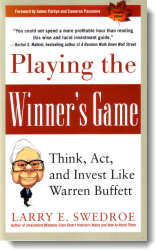Why should you add multiple asset classes to your portfolio? That seems like a simple question, but it’s one many investors would answer with only a vague comment about “more diversification.” It’s more precise to say you do so to increase expected returns or to decrease volatility. Sometimes these are mutually exclusive, but Harry Markowitz won a Nobel Prize for explaining that you can sometimes accomplish both at the same time. That insight is the basis for Modern Portfolio Theory.
One of the clearest illustrations of this idea can be found in Larry Swedroe’s book Think, Act, and Invest Like Warren Buffett, which I reviewed late last year. Swedroe shows how the return and risk characteristics of a 60/40 portfolio change as you slice and dice the equity allocations.
A portfolio made up of just the S&P 500 and five-year Treasuries returned 10.6% annually from 1975 through 2011, with a standard deviation of 10.8%. By gradually splitting that equity allocation into multiple asset classes (by international stocks, value stocks, small caps, and commodities) the portfolio’s annual return increased 150 basis points to 12.1%, while its volatility ticked up only 60 basis points to 11.2%.
It works in Canada, too
 How would things look if you started with Canadian stocks and bonds and then added US and international equities, as well as small-caps and value stocks? Now we know.
How would things look if you started with Canadian stocks and bonds and then added US and international equities, as well as small-caps and value stocks? Now we know.
PWL Capital has collaborated with Swedroe to bring out a Canadian version of his book, which has a new title: Playing the Winner’s Game. The advice is the same, but the portfolio examples have been Canadianized. And it turns out the data illustrate Modern Portfolio Theory even more dramatically. Here are the numbers for five portfolios combining various equity asset classes with a 40% allocation to short-term bonds from 1980 through 2012:
|
Equity allocation |
Return |
Volatility |
| Portfolio A |
Canadian equities only |
9.1% |
11.1% |
| Portfolio B |
Add Canadian value |
9.7% |
11.2% |
| Portfolio C |
Add US and international |
9.9% |
9.4% |
| Portfolio D |
Add small caps |
10.2% |
9.4% |
| Portfolio E |
Add REITs |
10.3% |
8.7% |
|
|
|
|
As you can see, in every case splicing the equity allocation increased returns and usually lowered volatility as well. As Swedroe explains, as we move from Portfolio A to E the return went up by 1.2 percentage points, which is a relative increase of 13%. Meanwhile, the standard deviation fell by 2.4 percentage points for a relative decrease of 22%. Higher returns, less risk—exactly what you should aim for when combining asset classes in a portfolio.
Cameron Passmore of PWL Capital’s Ottawa office, who co-wrote the foreword to the Playing the Winner’s Game, has offered to send copies to five readers. Enter below for a chance to win.
a Rafflecopter giveaway












